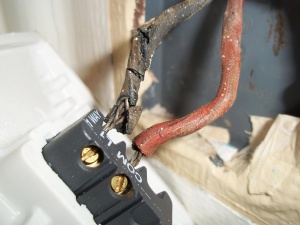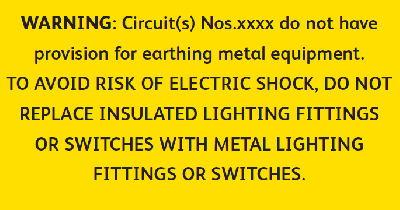Difference between revisions of "Lighting Circuits Without an Earth"
ARWadsworth (talk | contribs) (add link) |
(→Spotting them: twisted pair) |
||
| (7 intermediate revisions by 2 users not shown) | |||
| Line 3: | Line 3: | ||
==Background== | ==Background== | ||
| − | Many [[House Wiring for Beginners|lighting circuits]] (usually installed pre 1966) are still in use that have no earthing. | + | Many [[House Wiring for Beginners|lighting circuits]] (usually installed pre 1966) are still in use that have no [[earthing]]. (Note that the earth wire, is referred to in the wiring regulations (BS7671) as the Circuit Protective Conductor or CPC - so any notes you see in articles etc about "lighting circuits without a CPC" are discussing the same topic). |
| − | Rewiring these circuits is the preferable solution, but for some people the cost of installation and | + | [[Rewiring Tips|Rewiring]] these circuits is the preferable solution, but for some people the [[cost]] of installation and re[[decorating]] can be prohibitive. |
==Spotting them== | ==Spotting them== | ||
The ways these historic cicuits are spotted are: | The ways these historic cicuits are spotted are: | ||
| − | # When changing a fitting, only 2 core cable is fitted | + | # When changing a fitting or switch, only 2 core [[cable]] is fitted |
# Historic round bakelite switches | # Historic round bakelite switches | ||
| + | # Only two core cable connected in [[CU|consumer unit]] | ||
| + | # Twisted pair rubber wire at [[light]] fitting | ||
| + | |||
| + | Even the presence of modern [[Cable#T.26E|T&E cable ]] at a switch or light fitting does not guarantee the whole circuit has an [[earth]], since it may have been used to extend the [[circuit]] in the past. | ||
==Safety== | ==Safety== | ||
| − | Metal | + | Generally [[Metal]] faced switches switches must not be used on an unearthed lighting circuit. The exception to this are cases where the Metal light fittings are labelled with the [[image:DoubleInsulated.jpg]] Class II symbol. |
| − | |||
| − | |||
| − | |||
| − | |||
| − | |||
| − | |||
| − | |||
| − | |||
| − | |||
| − | |||
| − | |||
| − | |||
| − | |||
| − | |||
| − | |||
| − | |||
| + | Old [[lighting]] circuits may have other [[safety]] issues beyond just the lack of an earth conductor (and the lack of an earth conductor would suggest the circuit is at least 50 years old). See the [[Old electrical installations|old electrical installations]] article for more detail. | ||
==Reducing risk== | ==Reducing risk== | ||
| Line 37: | Line 26: | ||
:# Metal (Class I insulated) light fittings and metal accessories should be replaced with (Class II) fittings, which are either plastic, or metal and marked with the [[image:DoubleInsulated.jpg]] Class II symbol. | :# Metal (Class I insulated) light fittings and metal accessories should be replaced with (Class II) fittings, which are either plastic, or metal and marked with the [[image:DoubleInsulated.jpg]] Class II symbol. | ||
:# Insulation Resistance Test. The circuit should be tested between the line conductor (live and neutral connected together) and the earth terminal of the [[CU|consumer unit]]. The resistance should be at least 1 Megohm. If the resistance is less that 1 Megohm the circuit must have additional [[RCD]] protection. The test should also be repeated between the live & neutral conductors and any exposed conductive part of the circuit (eg the [[screws]] for a lightswitch with a metal backbox). Again if the readings are less than 1 Megohm then additional [[RCD]] protection is necessary. | :# Insulation Resistance Test. The circuit should be tested between the line conductor (live and neutral connected together) and the earth terminal of the [[CU|consumer unit]]. The resistance should be at least 1 Megohm. If the resistance is less that 1 Megohm the circuit must have additional [[RCD]] protection. The test should also be repeated between the live & neutral conductors and any exposed conductive part of the circuit (eg the [[screws]] for a lightswitch with a metal backbox). Again if the readings are less than 1 Megohm then additional [[RCD]] protection is necessary. | ||
| − | :# RCD protection. It is advisable to have 30mA [[RCD]] protection on lighting circuits that have no cpc, and essential if the resistance readings are lower than 1 Megohm. | + | :# RCD protection. It is advisable to have 30mA [[RCD]] protection on [[lighting]] circuits that have no cpc, and essential if the resistance readings are lower than 1 Megohm. |
:# Any 2A or 5A sockets connected to the lighting circuit that may be used for portable equipment should be disconnected. Dedicated clock connectors can be left in place. | :# Any 2A or 5A sockets connected to the lighting circuit that may be used for portable equipment should be disconnected. Dedicated clock connectors can be left in place. | ||
:# A warning notice similar to the one below should be fixed on or adjacent to the [[CU]] or fusebox: | :# A warning notice similar to the one below should be fixed on or adjacent to the [[CU]] or fusebox: | ||
| Line 45: | Line 34: | ||
==Potential problems== | ==Potential problems== | ||
===Extending the circuit=== | ===Extending the circuit=== | ||
| − | Not having an earth wire on a lighting circuit makes it impossible to extend the circuit for extra lighting points in a way that meets current wiring regulations. Extension can in principle be done safely if all switches, [[pattress]]es and lights are plastic, and remain plastic, but | + | Not having an earth wire on a lighting circuit makes it impossible to extend the circuit for extra lighting points in a way that meets current wiring [[regulations]]. Extension can in principle be done safely if all switches, [[pattress]]es and lights are [[plastic]], and remain plastic, but |
# regulations have demanded an earthed lighting circuit since 1966 | # regulations have demanded an earthed lighting circuit since 1966 | ||
# possible later replacement with metal fittings can make them unsafe | # possible later replacement with metal fittings can make them unsafe | ||
| Line 52: | Line 41: | ||
===Consumer unit upgrades=== | ===Consumer unit upgrades=== | ||
| + | [http://www.esc.org.uk/fileadmin/user_upload/documents/industry/best_practice/BPG1v2_web.pdf Best practice Guide] | ||
| + | |||
Many electricians may also refuse to swap a [[fusebox]] for a [[CU]] unless the old lighting circuit is also rewired. | Many electricians may also refuse to swap a [[fusebox]] for a [[CU]] unless the old lighting circuit is also rewired. | ||
| Line 58: | Line 49: | ||
== See Also == | == See Also == | ||
| + | * [http://www.esc.org.uk/fileadmin/user_upload/documents/industry/best_practice/BPG1v2_web.pdf Best practice Guide] | ||
* [[House Wiring for Beginners]] | * [[House Wiring for Beginners]] | ||
* [[Earthing Types]] | * [[Earthing Types]] | ||
Latest revision as of 22:55, 23 September 2017
Background
Many lighting circuits (usually installed pre 1966) are still in use that have no earthing. (Note that the earth wire, is referred to in the wiring regulations (BS7671) as the Circuit Protective Conductor or CPC - so any notes you see in articles etc about "lighting circuits without a CPC" are discussing the same topic).
Rewiring these circuits is the preferable solution, but for some people the cost of installation and redecorating can be prohibitive.
Spotting them
The ways these historic cicuits are spotted are:
- When changing a fitting or switch, only 2 core cable is fitted
- Historic round bakelite switches
- Only two core cable connected in consumer unit
- Twisted pair rubber wire at light fitting
Even the presence of modern T&E cable at a switch or light fitting does not guarantee the whole circuit has an earth, since it may have been used to extend the circuit in the past.
Safety
Generally Metal faced switches switches must not be used on an unearthed lighting circuit. The exception to this are cases where the Metal light fittings are labelled with the ![]() Class II symbol.
Class II symbol.
Old lighting circuits may have other safety issues beyond just the lack of an earth conductor (and the lack of an earth conductor would suggest the circuit is at least 50 years old). See the old electrical installations article for more detail.
Reducing risk
If a rewire is not an option then the following steps should be taken for safety reasons:
- Metal (Class I insulated) light fittings and metal accessories should be replaced with (Class II) fittings, which are either plastic, or metal and marked with the
 Class II symbol.
Class II symbol. - Insulation Resistance Test. The circuit should be tested between the line conductor (live and neutral connected together) and the earth terminal of the consumer unit. The resistance should be at least 1 Megohm. If the resistance is less that 1 Megohm the circuit must have additional RCD protection. The test should also be repeated between the live & neutral conductors and any exposed conductive part of the circuit (eg the screws for a lightswitch with a metal backbox). Again if the readings are less than 1 Megohm then additional RCD protection is necessary.
- RCD protection. It is advisable to have 30mA RCD protection on lighting circuits that have no cpc, and essential if the resistance readings are lower than 1 Megohm.
- Any 2A or 5A sockets connected to the lighting circuit that may be used for portable equipment should be disconnected. Dedicated clock connectors can be left in place.
- A warning notice similar to the one below should be fixed on or adjacent to the CU or fusebox:
- Metal (Class I insulated) light fittings and metal accessories should be replaced with (Class II) fittings, which are either plastic, or metal and marked with the
Potential problems
Extending the circuit
Not having an earth wire on a lighting circuit makes it impossible to extend the circuit for extra lighting points in a way that meets current wiring regulations. Extension can in principle be done safely if all switches, pattresses and lights are plastic, and remain plastic, but
- regulations have demanded an earthed lighting circuit since 1966
- possible later replacement with metal fittings can make them unsafe
One viable workaround to add lighting points, is to feed them via another circuit that does have an earth wire. This can be another more recent lighting circuit, or can be a socket circuit via a fused connection unit (with a 3A or preferably a 5A fuse).
Consumer unit upgrades
Many electricians may also refuse to swap a fusebox for a CU unless the old lighting circuit is also rewired.
Unsuitable wire
Most unearthed lighting circuits are wired with historic cable (often old imperial twin PVC) that can handle the required load of the lighting circuit. But there are also circuits in use with unsuitable cable, such as bell wire and speaker wire. If such wire is found it should be disconnected from the supply immediately.

